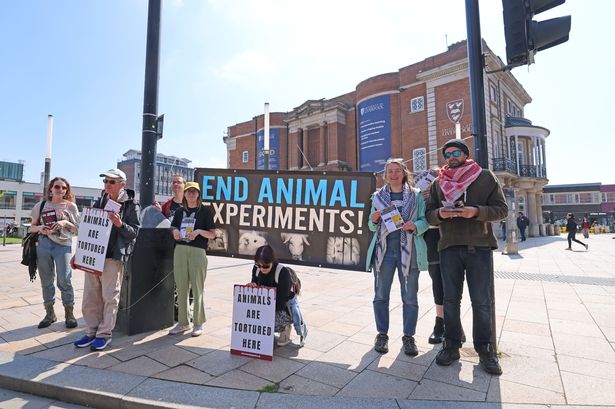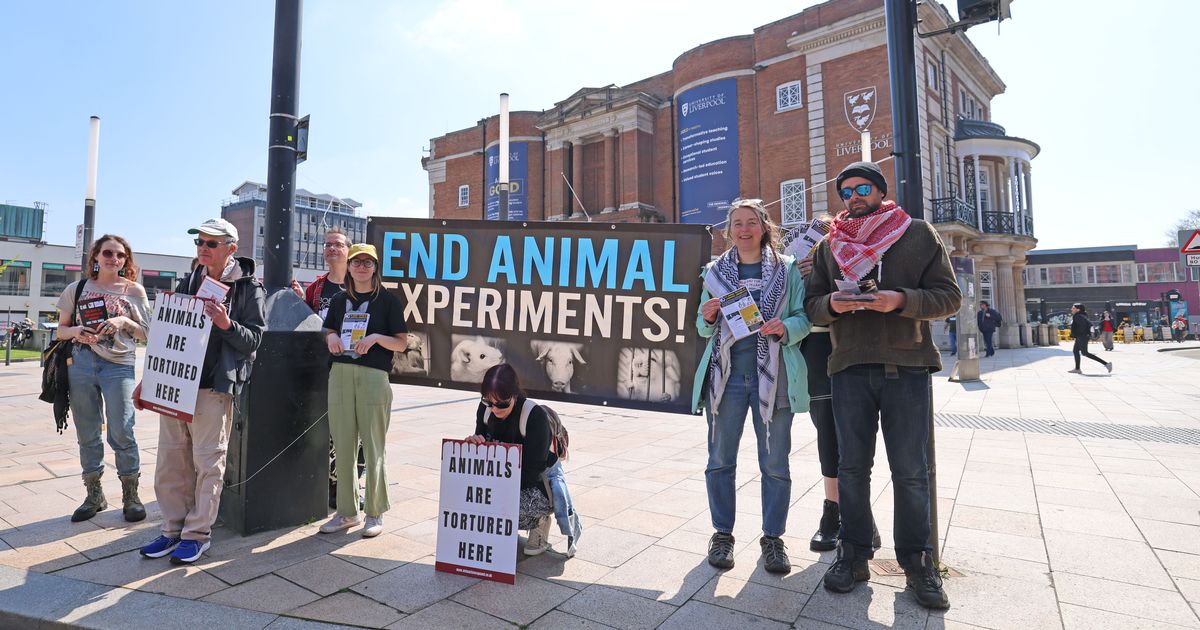The University of Liverpool carried out a total of 14,112 procedures on animals in 2024
08:47, 05 May 2025Updated 08:47, 05 May 2025
 Merseyside Animal Rights members protest outside Liverpool University(Image: Liverpool ECHO)
Merseyside Animal Rights members protest outside Liverpool University(Image: Liverpool ECHO)
The University of Liverpool carried out thousands of animal experiments last year. According to figures obtained by Merseyside Animal Rights, and shared with the ECHO, a total of 14,112 procedures on animals took place in 2024.
The university says “there is overwhelming scientific consensus that some work must continue in order to make medical progress that will save and improve lives”, and that it was committed to the “reduction, refinement and replacement of animal models.”
According to the figures, the most commonly experimented on animals were mice, with 8,390 procedures being carried out under the Animals (Scientific Procedures) Act (ASPA) 1986 last year. This was followed by cattle, with 1,965 procedures.
Other animals that were experimented on included sheep (2,668), rats (619), hamsters (194), rabbits (104), domestic fowl (75), fallow deer (2) and roe deer (2).
A number of other types of bird were also subject to ASPA experiments, including common guillemots (37), European shags (29), razorbills (20), and kittiwakes (7).
6,846 of the experiments were determined to cause the animals “mild” pain, under Home Office classifications. 3,833 experiments caused “moderate” pain, 151 caused “severe” pain, and 98 were classed as “non-recovery”, meaning the animal is placed under general anaesthetic before the start of the procedure and killed without regaining consciousness.
A further 3,184 experiments were classed as “sub-threshold”, which occurs when a procedure was originally considered to cause above-threshold pain or suffering, but in retrospect this did not occur.
Examples of sub-threshold procedures include breeding of genetically altered animals without a harmful phenotype, and dosing with a compound in feed where the animals ate normally and suffered no ill consequences.
In its response to the Freedom of Information request, the University of Liverpool stated: “The research supports advances in both human and animal health and covers basic and translational/applied research, protection of natural environment, and higher education and training.”
It also said: “The university adheres ruinously to the principles of the ‘3 Rs’ (reduction, refinement and replacement), including replacement, and only uses protected animals for research when there are no alternatives.”
Animal rights campaigners gathered in University Square, on the corner of Brownlow Hill and Mount Pleasant, in protest after the new findings.
Katy Brown, of Merseyside Animal Rights, said “The figures show that the university is clearly not embracing any of these three principles, known as ‘the 3Rs’. If the university was genuinely interested in reduction, its figures for animals used would be reducing, not increasing.”
She claimed that while the number of mice experimented on had dropped by about 20% since 2023, the number of experiments on rats and sheep had doubled, and the number of cows used had tripled.
The animal rights group said the use of animals as models for both toxicity testing and human disease research is increasingly being called into question.
According to the Home Office, the annual number of procedures has been falling steadily since 2015. Numbers peaked in the 1970s, at around 5.6 million per year, before falling to around 2.7 million per year in the 1990s and early 2000s.
The most recent figures for Great Britain, released in 2023, found 2,681,686 experiments using animals were carried out that year. Around half (52.4%) of all experiments were carried out for basic fact-finding research, while a quarter (25.1%) were for applied research (the study of human diseases and treatments).
Katy said: “Positively, in recent years, there has been a shift in focus towards the replacement aspect of the 3Rs with calls from within the scientific community to accelerate the replacement of animals in research and testing with more human relevant alternatives on both scientific and ethical grounds.
“Unfortunately, the University of Liverpool seems determined, despite its claims to the contrary, to remain bound to the outdated animal model for research. Merseyside Animal Rights was extremely disappointed to learn that the figures for animal experiments have gone up, rather than down, in the last year.”
A University of Liverpool spokesperson said: “While new methods have enabled researchers to considerably reduce work involving animals, there is overwhelming scientific consensus that some work must continue in order to make medical progress that will save and improve lives.
“Animal research is used to ensure new medicines and chemicals are safe for people, animals and the environment, with severe procedures most often arising in regulatory testing procedures.
“The University of Liverpool is committed to the principles of reduction, refinement and replacement of animal models. For each of our research projects this ensures, as far as is reasonably practicable, that no non-animal alternative is possible, that the number of animals used is minimised and that procedures and standards of care are refined to maximise welfare.”
